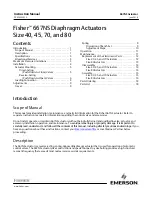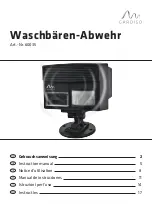
Instruction Manual
D102603X012
667NS Actuator
June 2018
6
9. Push the valve stem firmly against its seat, and be sure that it remains firmly against the seat. Clamp the actuator
stem and valve stem between the two stem connector halves.
If necessary, increase actuator loading pressure slightly to allow the valve stem, actuator stem, and stem connector
threads to match.
Insert and tighten the stem connector cap screws.
WARNING
To avoid personal injury due to the sudden, uncontrolled movement of parts, do not loosen the cap screws when the stem
connector has spring or loading pressure force applied to it.
10. Raise the travel indicator disk (sizes 40 through 70 only) to the stem connector. For all sizes, thread the stem
locknuts against the stem connector.
11. Remove all actuator loading pressure. Move the travel indicator scale so that the indicator disk (or pointer) is in
line with the bottom mark of the travel indicator scale.
12. Check the valve travel to be sure that the valve travels fully with no overtravel.
Reverse‐Acting (Push‐Down‐to‐Open) Valves
Refer to figure 1.
1. Screw the stem locknuts all the way onto the valve stem. Put the travel indicator disk, not used with the size 80
actuator, on the locknuts. The concave side of the disk should face the valve.
2. Place the actuator on the valve bonnet.
3. Insert the cap screws and tighten the hex nuts (not shown), securing the actuator to the bonnet. Tighten the cap
screws to the torque in table 4.
Note
Before turning the spring adjuster on size 70 or 80 actuators, assemble the stem connector around the actuator stem and the
anti‐rotating lug on the yoke. Mark the actuator stem as a visual reference to verify that stem rotation does not occur. Remove the
stem connector before rechecking the bench set.
4. (For size 80, remove the cap screw (key 91, figure 4) and remove the adjusting screw cover (key 84, figure 4).
Rotate the spring adjustor (key 74, figure 2 for sizes 40 and 45; key 74, figure 4 for size 70; and key 74, figure 4 for
size 80) to position the actuator stem at its fully extended position.
5. With the travel indicator scale attached to the actuator yoke, make a temporary mark on the actuator stem in line
with the bottom mark on the scale (the mark on the end of the scale that is marked “OPEN”). (The distance from the
bottom mark on the scale to the top mark is equal to the travel of the valve.)
6. Refer to the actuator nameplate to determine the bench set pressure range of the actuator. Apply an actuator
loading pressure to the actuator equal to the lower end of the bench set range and rotate the spring adjustor until
the mark you made on the actuator stem is in line with the bottom mark on the travel indicator scale. (Replace the
size 80 adjusting screw cover and cap screw when you have completed the adjustments.)







































